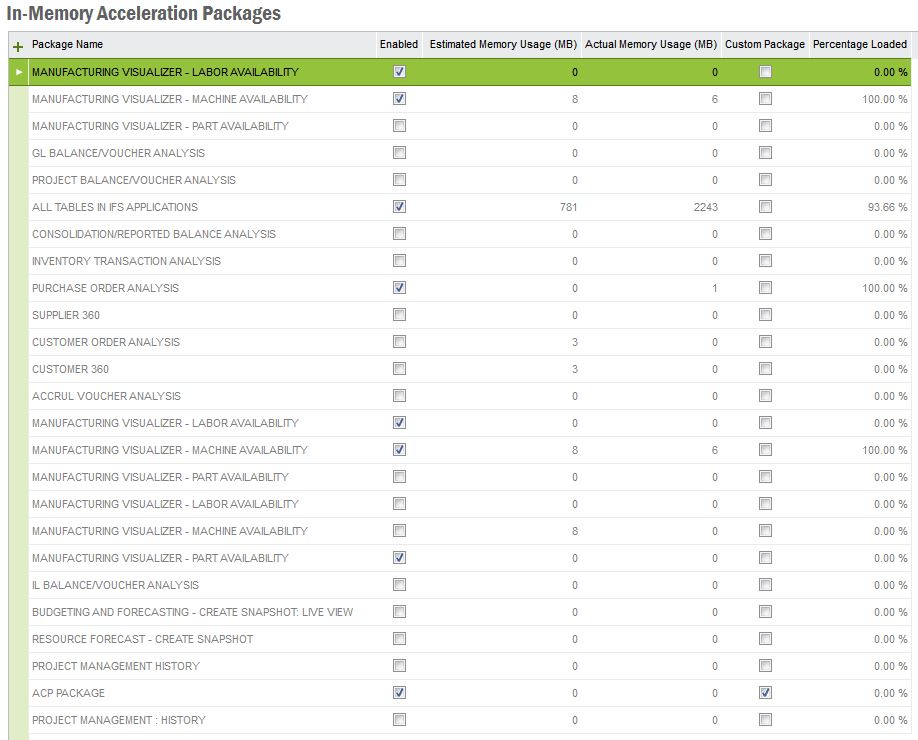
IFS Applications enable users to leverage Oracle In-Memory columnar store introduced in Oracle 12C Enterprise Edition. With In-Memory acceleration, users will be able to run analytical queries against IFS Applications several magnitudes faster than before.
Type of queries that will mostly benefits from In-Memory are:
IFS Applications includes In-Memory Acceleration Packages in its standard offering. Above these prepared In-Memory Acceleration Packages, customers can create their own acceleration packages. In an environment without Oracle Enterprise Edition, these packages are still included but in order to use them you need to have the Oracle 12C (or newer) Enterprise Edition database installed together with the In-Memory option enabled. An In-Memory Acceleration Package contains one or several database objects (i.e. tables and materialized views) that could be loaded into the In-Memory area.
Note: If the database is lifted to Enterprise Edition, or if the In-Memory option is enabled on an existing database, it is necessary to run the Prepare Database step and redeploy all database objects again.
The In-Memory Acceleration Packages window displays all the In-Memory Acceleration Packages that are installed in IFS Applications
Details listed in this view include:

From the In-Memory Package Acceleration Packages window, user have these context menu options:
In the In-Memory Acceleration Package window user can view and edit database objects related with a In-Memory Acceleration Package.

All the Context Menu options found in In-Memory Acceleration Packages window are also available in this window. Additionally, there is an option to drop non-mandatory, analytical indexes for the database objects related with this In-Memory Acceleration Package. The option Remove Analytical Indexes is only available when that In-Memory Acceleration Package is enabled for In-Memory.
Note: Dropping the analytical indexes is a non reversible operation.
However, since all DDL commands to recreate those indexes can be found in the Database Alert Log under Category ID In-Memory, it is possible to manually rebuild them.
It is possible to create custom In-Memory Acceleration Packages. It is done in the same windows meaning that all functionality like calculating estimated memory requirement, enabling/disabling In-Memory Acceleration Packages, etc. is available as well. A custom In-Memory Acceleration Package contains some header information and a list of related database objects (i.e. tables and materialized views). Please note that user cannot edit In-Memory Acceleration Packages that are provided by IFS or when it is enabled for In-Memory.
In-Memory Advisor Lobby page shows essential status of the In-Memory Acceleration Packages.
When an In-Memory Acceleration Package is enabled, the system will replicate all included
tables into the In-Memory area. To save space, In-Memory tables are compressed
when loaded into the memory. The
compression level can be altered to suit system administrator's
preference. This is done in the
System Parameters window
and in the parameter In-Memory compression level.
The default compression level is set to QUERY_LOW meaning that the compression
is optimized for querying rather than space saving.
Available compression levels are
All the memory operations such as estimates and enabling will use this setting. Hence, In-Memory Acceleration Packages need to disabled from In-Memory and enabled again to get affect from a change of the compression level. In-Memory estimates need to be carried out individually per compression level.
Custom fields tables are supported with In-Memory Acceleration Packages. When persistent custom fields are enabled, all relevant custom fields tables are automatically added to the In-Memory Acceleration Packages that contain the base tables for that particular custom fields.
Note: If you enable custom fields for a table that is already In-Memory enabled, you have to explicitly re-enable the package in order to enable the custom field table. Same procedure need to be followed for estimating In-Memory requirements.